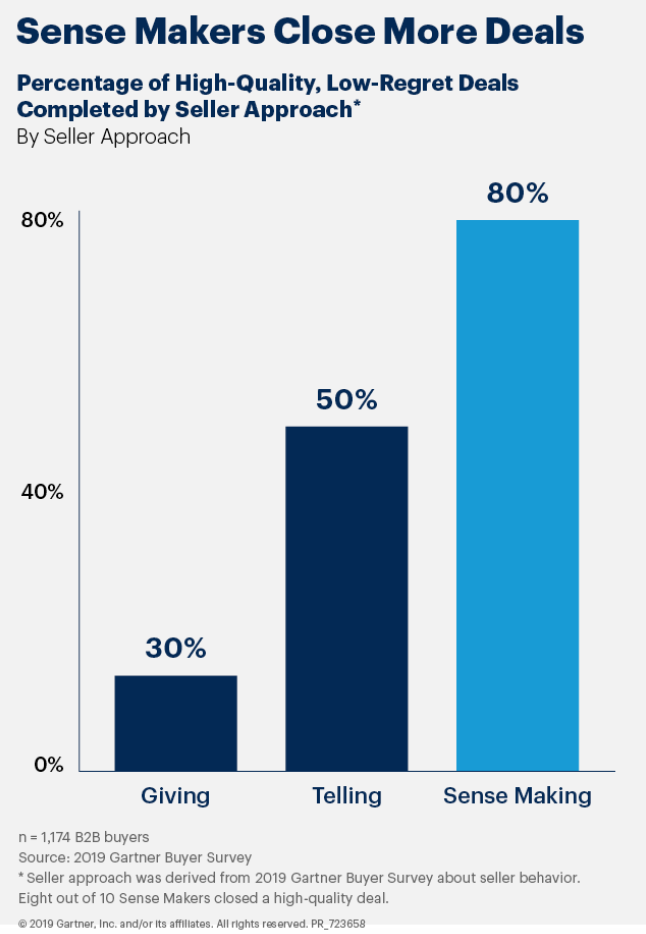This Week’s Big Deal: Helping Buyers Overcome Information Fatigue
Information overload is real. And for today’s B2B buyers, it’s a real problem.
There was a time when it was difficult to find enough quality information while researching solutions and weighing options. Now, this dynamic has swung starkly in the opposite direction.
There’s so much information out there, it can put decision makers in a state of fatigue. And new data suggests this struggle is having a negative impact on the willingness of companies to make bold investments — even those that might benefit them.
Shying Away From Big Decisions Amidst Big Confusion
A Gartner report released last week, sharing insights from a survey of more than 1,000 B2B buyers, found that 89% are finding high-quality information during the purchase process. That seems good, on the surface.
“However,” Gartner explains, “this abundance of quality information is hindering customer decisions, as they report not only being overwhelmed by the amount of trustworthy information, but often contradictory information among suppliers as well.”
It turns out that when buyers are given too much info — often presenting conflicting narratives, to advance the interests of various sellers — it’s no better than having too little.
As Gartner vice president Brent Adamson puts it: “Customers are reaching an information saturation point, where each new idea reduces the value derived from information and turns sound decision making into ‘best guesses’ or ‘gut feeling’ choices.”
This is having a material effect on outcomes, according to the research. Gartner finds that, “when customers experience too much high-quality information, information that is contradictory and creates difficulty in making informed purchase decisions, they are 153% more likely to settle for a course of action smaller and less disruptive than originally planned.”
In this setting, a salesperson’s role is shifting — from simply being a provider of information, to being someone who assists with navigating this information. Or, as Gartner puts it, a sense maker.
Making Sense of the Information Deluge
Gartner points to three different common selling approaches. “Giving” means providing as much information (aka content) as possible to help a customer make a decision. “Telling” means speaking out of personal expertise and authority to address a customer’s specific needs. And “sense making” means helping customers evaluate all of the information and guidance they’re receiving from numerous sources, reconciling contradictory points and prioritizing the most relevant ones.
As the chart below shows, sense makers are handily outperforming the other two approaches when it comes to completing high-quality, low-regret deals:
In the interest of adopting your customer’s point of view, this is a critical opportunity. How can we empathetically position ourselves as beacons of clarity in a sea of murkiness?
Here are a few suggestions:
Ask Good Questions
Sales expert Nancy Nardin, who was featured last month in our Insight Track series, recently sat down for an interview with SmarterCX on B2B sales best practices and trends. One key recommendation she makes is bringing a sense of open-minded curiosity to the table, rather than falling back on the traditional, transparently pushy lines of questioning.
"If you're going in and you're asking the customer about their budget and their authority and their need and their timing, they're gonna go, get out!" she asserts. "That's just not a place to start. You have to add value, and that's part of the customer experience."
"It's more and more difficult to differentiate yourself by product or price or even delivery of product," Nardin adds. "So it starts with, what is my interaction with the salesperson like? That's going to give me a feel, and if they're asking me good questions, that's a good thing."
What are “good questions” in this scenario? They’re the types that make your conversation about the buyer, not the seller. The only way to determine where a decision maker is hitting snags is to learn it from them. So if you know someone is in an active evaluation stage, try opening the conversation around challenges in their selection process, rather than jumping right to the business problem they’re trying to solve through said process.
Lean on Your Marketing Cohorts
Marketers specialize in communication, and making complex information digestible. Set aside the traditional divide and coordinate with this department to refine a system for helping prospective buyers find their way through the fray. Since sellers tend to have first-hand insights around where decision makers are struggling or encountering confusion, they can assist with the creation of content tailored to these situations.
Resources like guides, comparison sheets, and FAQs are appreciated by buyers trying to get the lay of the land. As Beibei Bai wrote here last week, video can be especially effective for building trust by showing, rather than telling.
Deliver Content More Smoothly
Given the amount of content buyers are dealing with, it’s important that sellers package it up in a way that is clean, straightforward, and easy to peruse. LinkedIn Sales Navigator features tools designed expressly for this purpose.
Rather than unloading a bunch of email attachments on a prospective customer, you can send them a simple dedicated URL, which leads to a nicely organized (and branded) landing page featuring your hand-picked content. At a time where buyers are telling us that they are flustered by information fatigue, this offers a way to show we’re listening.
Become a sense maker, and customers will quickly come to see why it makes sense to work with you.
Subscribe to the LinkedIn Sales Blog and never miss out on the latest big deal in B2B sales.
Topics: Sales trends
Related articles






